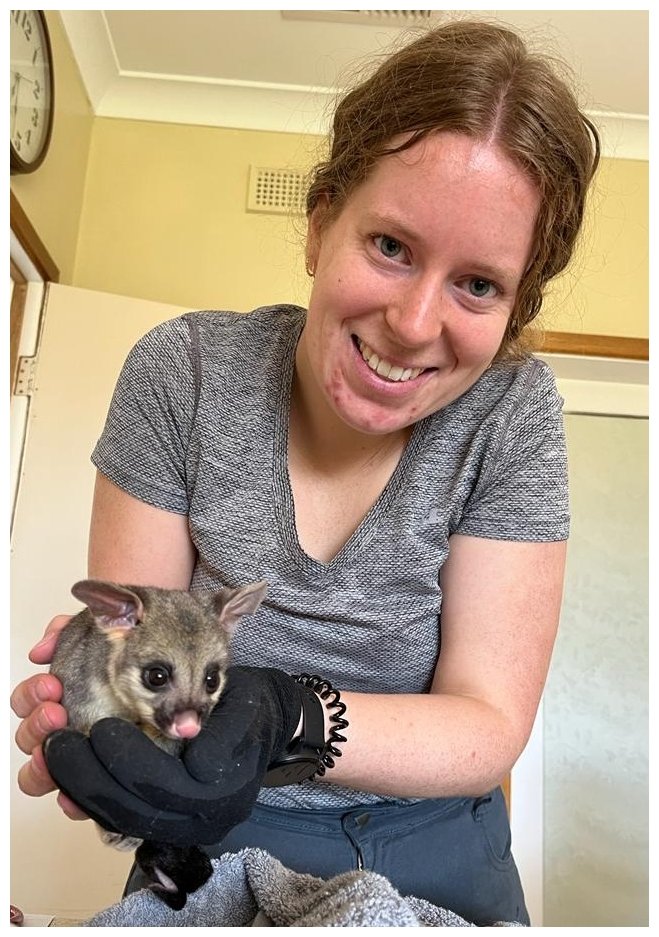A Park Lands possum joey, still in its mother's pouch, has been found to be in good health, despite its mother's serious illnesses.
Researcher Tara McKenzie has found dozens of possums in your Park Lands (see below) but is concerned that some of them are in very poor health. Here’s her latest report:
I continued my trapping efforts up until just before Christmas and had some surprising finds in the last group of possums that were captured.
Pic: Tara McKenzie
I moved back to trapping in Park 17 where I was based for the spotlighting surveys and in a single trap night caught two interesting cases.
The first was an adult male who appeared very healthy but was burdened with ticks. We removed several ticks from the ears and the capture bag of the possum and will identify the species of these in the coming month.
This was an interesting case as it was the first possum I have captured in the Park Lands found with ticks. I have caught several possums [with ticks] from my research site on an agricultural property, but nowhere else, so they were a surprise to see.
The second case was an adult female, who even at first glance, we knew was not in the best way.
This female was suffering from possum dermatitis, an unfortunately quite common condition seen in possums that come into care in wildlife rescues and vets, but also suffering from ulcers in the mouth and ocular damage to both eyes.
Eye damage to an adult female possum. Pic: Tara McKenzie
These conditions are usually associated with stress in brushtails and are often chronic.
Despite this female being in such poor condition, this female was found to have a very healthy approximately 4 month old joey in its pouch.
We examined the joey and found no signs of disease or stress, which was great to see.
We took a blood sample for later analysis and conducted microbial analysis on swabs of the pouch, eyes, mouth, urogenital tract and skin lesions, but found no bacterial cause for these issues, so we will be conducting further research and analysis to find out the cause of these issues.
Pic: Tara McKenzie
Speaking of further research - in order to find out a bit more about the rates of disease in the Park Lands possum population, I have reached out to Fauna rescue, the Adelaide Koala & Wildlife Centre and ZoosSA to see what data they may have available that could help create a picture of the health status of the Park Lands possums.
Turns out - they all have a lot of data, so my next challenge will be to go through it all to see what it can tell us.
I have also been able to collect some recently deceased possums from the Park Lands, which will undergo a post-mortem where we are able to look for any internal signs of disease and collect histological and tissue samples for further analysis.
Where’s the best place to see a Park Lands possum?
It seems that the best location, at least in your southern Park Lands, would be in Carriageway Park /Tuthangga (Park 17) or the neighbouring Peppermint Park / Wita Wirra (Park 18).
Tara reports the possum population density in those two Parks, averaging 14 or 15 per hectare, is much higher than has been found in other parts of your southern Park Lands.
The number of possums found in each of Parks 16 to 20, plus Whitmore Square. Data: Tara McKenzie
Tara is surveying possums throughout your Park Lands, but in recent weeks has been concentrating on the southern Park Lands. Here’s her most recent “spotlighting” report:
Parklands spotlighting survey:
I made significant progress in my spotlighting survey of the Park Lands. I am surveying both the brushtail and ringtail populations and have been quite surprised by the results.
I have 49 transects to survey, totalling 24km, each for four consecutive nights. I have completed the surveys of 13 transects and a summary of the results are below.
Many of these surveys where done between those very severe storms we had through December, but I am happy to report that despite the damage to trees and the wild winds, the Park Lands possums made it through unscathed, and seemed to take the opportunity to explore outside of their normal range. I have attached some photos.
Maximum possum density - based on the largest number of possums recorded over the survey nights:
Whitmore Square = 7.5 possums/hectare
max recorded across survey period = 17
Park 16 = 2.8 possums/hectare
Max recorded = 5 possums
Park 17 = 15 possums/hectare
Max recorded = 61 possums
Park 18 = 14.2 possums/hectare
Max recorded = 17 possums
Park 19 = 2.4 possums/hectare
Max recorded = 7 possums
Park 20 = 0.6 possums/hectare
Max recorded = 1 possums
Ringtails and brushtails regularly cohabitate very closely without conflict.
A brushtail possum in Whitmore Square. Pic: Tara McKenzie
I have sampled all of the squares as well but none were observed except in Whitmore Square.
Tara McKenzie is a University of Adelaide researcher, studying Brushtail possums both in the Riverland, and in your Adelaide Park Lands.
Her research includes an internship with the Adelaide Park Lands Association where her main role is to collect information about the plant and animal species that are found across your Park Lands, with a focus on those that have an important role in possum habitats.









